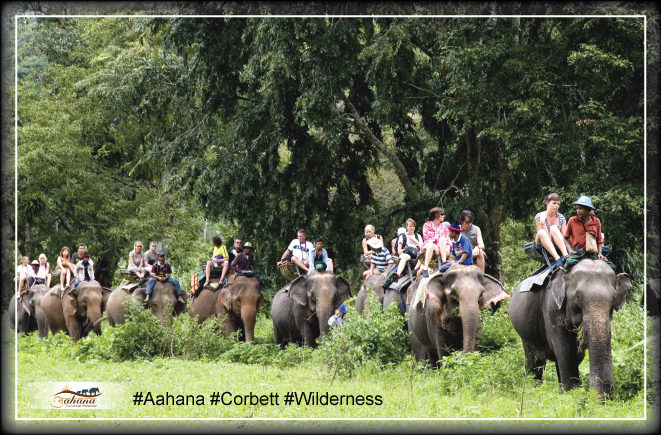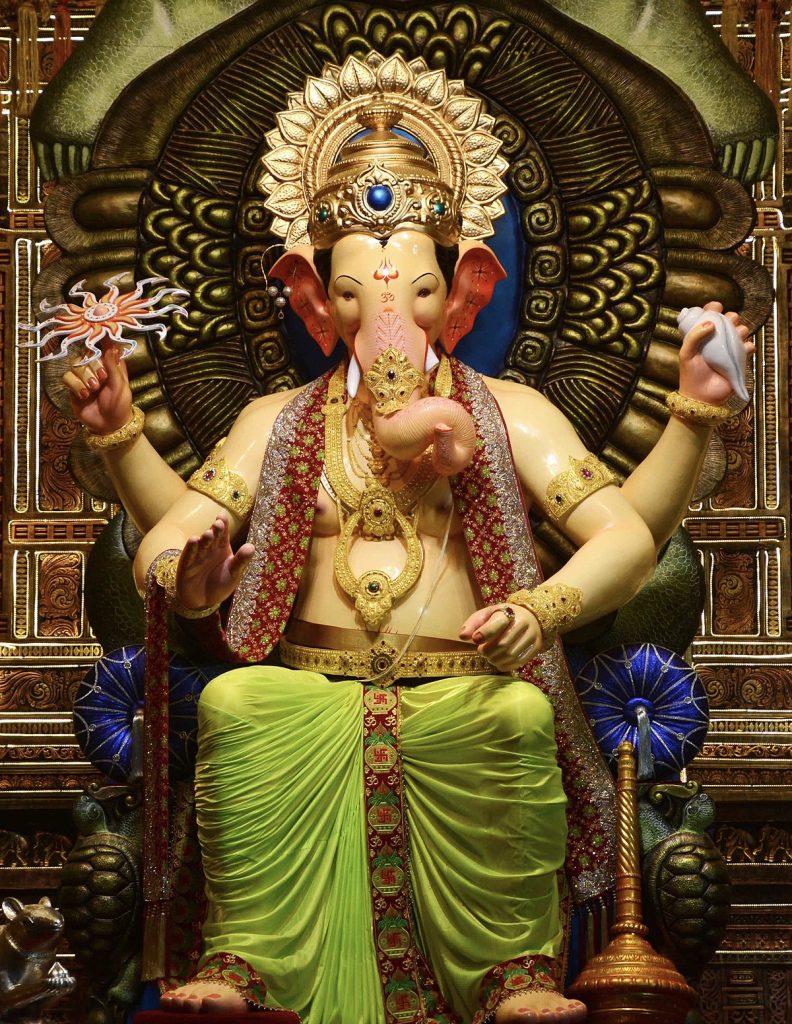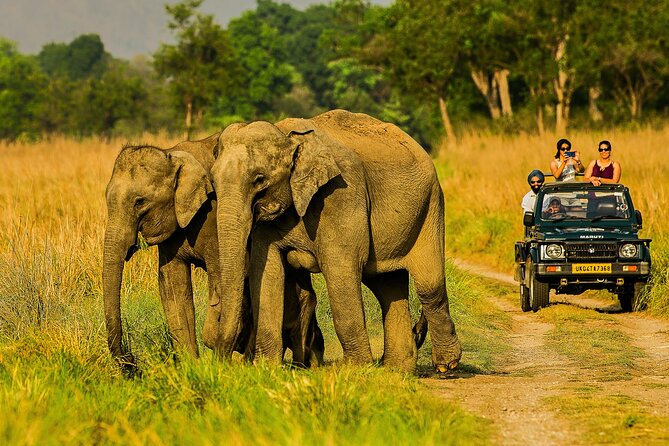Wildlife safaris in Corbett offer an exciting adventure. They bring you close to nature’s wonders.
Imagine exploring dense forests, spotting majestic tigers, and hearing the calls of wild birds. Corbett National Park, India’s oldest national park, provides an unforgettable safari experience. It boasts a rich variety of wildlife and breathtaking landscapes. Whether you’re a nature lover or a thrill seeker, a safari here is perfect.
You’ll journey through diverse terrains, from grasslands to riverine belts. Every moment in Corbett is a chance to witness nature’s beauty. Prepare for an adventure that will leave you with memories for a lifetime.
Introduction To Corbett Wildlife Safaris
Imagine waking up to the melodious chirping of exotic birds, the rustling of leaves as a majestic tiger prowls through the dense forest, and the invigorating scent of fresh, dewy earth. Welcome to Corbett Wildlife Safaris—a paradise for nature lovers and adventure seekers alike.
Brief History
Corbett National Park, named after the legendary hunter-turned-conservationist Jim Corbett, is India’s oldest national park. Established in 1936, it was originally called Hailey National Park. The park’s rich history is intertwined with efforts to protect the Bengal tiger and other endangered species. Jim Corbett’s legacy lives on, inspiring conservation practices that continue to protect the park’s diverse wildlife.
Did you know Corbett National Park was the first to be included under the Project Tiger initiative in 1973? This groundbreaking effort aimed to safeguard the dwindling tiger population, making Corbett a crucial habitat for these magnificent creatures.
Unique Ecosystem
Corbett National Park boasts a unique ecosystem that supports a myriad of flora and fauna. The park’s diverse landscape includes riverine belts, grasslands, marshy depressions, and dense forests. Each of these habitats plays a critical role in sustaining the park’s biodiversity.
- Riverine belts: Home to creatures like otters and gharials, these areas offer a tranquil and picturesque setting for wildlife enthusiasts.
- Grasslands: Perfect for spotting herbivores such as elephants and deer. The open spaces make wildlife sightings more frequent and exciting.
- Dense forests: These forests are the heart of Corbett, providing shelter to leopards, tigers, and numerous bird species.
Have you ever wondered why Corbett is such a hotspot for wildlife? It’s the unique interplay between these varied habitats. The park’s ecosystem supports over 600 species of birds, 33 species of reptiles, and countless insects and plants. This makes every safari an unpredictable adventure where you never know what fascinating creature you’ll encounter next.
When you embark on a safari in Corbett, you are not just witnessing wildlife; you are immersing yourself in an intricate web of life. Every corner of the park tells a story of survival, adaptation, and coexistence.
So, are you ready to explore the wild and unravel the mysteries of Corbett’s unique ecosystem? Your adventure awaits!

Credit: www.tigersafariindia.com
Best Time To Visit
Planning a wildlife safari in Corbett is an exciting adventure. To make the most of it, knowing the best time to visit is crucial. Different seasons offer unique experiences. Let’s explore the optimal times for your safari adventure.
Seasonal Highlights
The best time to visit Corbett is from November to June. During these months, the park remains open, and animal sightings are frequent. November to February is winter. The weather is cool, and the park is lush green. March to June is summer. Water sources dry up, so animals gather around the remaining water bodies. This makes it easier to spot them.
Weather Considerations
Winter in Corbett is pleasant. Days are warm, but nights can be chilly. Carrying warm clothes is advisable. Summer can be hot, with temperatures soaring up to 40°C. Light clothing, hats, and sunscreen are essential. The monsoon season, from July to September, brings heavy rainfall. The park remains closed during this period for safety reasons.
Top Safari Zones
Explore the thrilling wildlife safaris in Corbett. Home to tigers, elephants, and diverse bird species, Corbett offers unique safari experiences. Discover nature’s wonders in this renowned Indian national park.
Are you ready for an unforgettable adventure? In Corbett National Park, you can experience the thrill of a lifetime on a wildlife safari. This park is divided into several zones, each offering unique experiences and wildlife sightings. Let’s dive into the top safari zones that you absolutely must explore.Dhikala Zone
Dhikala Zone is the heart of Corbett National Park. Famous for its stunning landscapes and rich biodiversity, this zone is a must-visit for any wildlife enthusiast. The vast grasslands and dense forests create a perfect habitat for a variety of wildlife. You might be wondering, what can you see in Dhikala Zone? Well, it’s not just about the majestic Bengal tiger, although spotting one is a highlight. You’ll also encounter elephants, deer, and an array of bird species. The panoramic views from Dhikala’s watchtowers are unmatched. Don’t miss the opportunity to stay at the Dhikala Forest Lodge. It’s one of the best ways to immerse yourself fully in the wild, with the sounds of nature providing a perfect backdrop.Bijrani Zone
Bijrani Zone is another gem in Corbett National Park. Known for its dense forests and open grasslands, Bijrani offers a slightly different safari experience compared to Dhikala. The terrain here is varied, making it an exciting zone for wildlife photography. During my visit to Bijrani, I was lucky enough to witness a herd of elephants bathing in a waterhole. Such moments are priceless and make you appreciate the beauty of nature even more. Bijrani is also a great place for bird watchers. The zone is home to many bird species, making it a paradise for ornithologists. If you’re keen on bird photography, Bijrani will not disappoint. So, which zone are you planning to explore first? Each zone in Corbett National Park has its own charm and offers unique experiences. Whether it’s the vast landscapes of Dhikala or the varied terrain of Bijrani, you’re sure to have an adventure you’ll never forget.
Credit: www.aahanaresort.com
Wildlife Species To Spot
Corbett National Park is a treasure trove for wildlife enthusiasts, offering a thrilling opportunity to witness a diverse range of species in their natural habitat. As you embark on a wildlife safari, keep your eyes peeled and your camera ready. You never know what you might spot. Here are some of the incredible wildlife species you should look out for:
Bengal Tigers
The most sought-after sight in Corbett is undoubtedly the majestic Bengal Tiger. With its striking orange coat and black stripes, the Bengal Tiger is a symbol of power and grace. During your safari, listen to the jungle sounds. The alarm calls of deer and monkeys can indicate a tiger’s presence. I remember the adrenaline rush when we spotted one lounging near a waterhole—an unforgettable moment.
Elephants And More
Elephants are another highlight of the park. These gentle giants often travel in herds, creating a spectacular sight. Watch out for their playful antics, especially the young calves. Additionally, Corbett is home to a variety of other fascinating creatures. You might see:
- Leopards: Elusive and stealthy, leopards are expert climbers. They often rest in the branches of trees.
- Deer: Spotted deer, sambar, and barking deer are common sights. Their grace and alertness are captivating.
- Birds: With over 500 bird species, bird watchers will be delighted. Keep an eye out for the colorful Indian Pitta or the majestic Crested Serpent Eagle.
What will you discover on your safari? The thrill of the unknown keeps the adventure alive. Each visit to Corbett brings a new surprise. So, pack your bags and get ready for an unforgettable wildlife experience. What species are you most excited to spot?
Safari Types
Exploring the wilds of Corbett offers a thrilling experience. Different safari types cater to various interests and adventure levels. Among these, jeep safaris and elephant safaris stand out. Each provides a unique way to witness the beauty and wildlife of Corbett.
Jeep Safaris
Jeep safaris are popular in Corbett. They offer an exciting way to explore the park. Covered in an open vehicle, you get closer to nature. The open jeeps allow you to see animals clearly. Morning and evening slots are available. Each provides a different experience. Guides accompany you to share insights about the wildlife. The bumpy ride adds to the adventure. Remember to carry your camera. You might spot tigers, elephants, and various birds.
Elephant Safaris
Elephant safaris offer a unique experience. Riding on an elephant’s back gives a different perspective. You can reach places where jeeps can’t go. The slow pace allows you to observe the surroundings. The mahout, or elephant driver, guides you through the dense forest. This safari is perfect for those seeking a quiet adventure. It’s an excellent way to see deer, monkeys, and birds. The ride is gentle, making it suitable for all ages. Elephant safaris are a memorable part of visiting Corbett.
Accommodation Options
Corbett National Park offers a range of accommodation options. Whether seeking luxury or a budget-friendly stay, you will find suitable choices. Each option provides a unique experience, catering to different preferences. Let’s explore the available accommodations.
Luxury Resorts
Luxury resorts in Corbett provide top-notch facilities. They offer spacious rooms with modern amenities. Guests can enjoy fine dining and spa services. These resorts often have swimming pools and fitness centers. Some even organize private safaris and nature walks. Expect excellent service and a comfortable stay.
Budget Stays
Budget stays are perfect for cost-conscious travelers. These accommodations are simple yet comfortable. Basic facilities like clean rooms and decent food are provided. Many budget stays are close to the park entrance. This convenience is ideal for early morning safaris. Experience the wilderness without breaking the bank.
Photography Tips
Exploring the wilderness of Corbett National Park through the lens of your camera is an experience like no other. Capturing the raw beauty of wildlife and the untouched landscapes requires some preparation and knowledge. Here are some practical photography tips to help you get the best shots during your wildlife safari in Corbett.
Best Gear
Choosing the right gear can make a significant difference in your photography. A good DSLR or mirrorless camera with a zoom lens is ideal. Consider a lens with a focal length of at least 300mm to get close-up shots of animals from a safe distance. If you’re into bird photography, a lens with even more reach is beneficial.
- Camera Body: DSLR or mirrorless with fast autofocus.
- Lens: 300mm or higher for wildlife, 100-200mm for landscapes.
- Accessories: Tripod, extra batteries, and memory cards.
Personally, I found that my 400mm lens allowed me to capture the intricate patterns on a tiger’s coat from a distance, without disturbing the animal. What gear do you find indispensable?
Optimal Timings
Timing is everything when it comes to wildlife photography. Early mornings and late afternoons are the best times to spot animals and capture them in the golden light. During these hours, the animals are more active, and the soft light enhances the details and colors in your photos.
Plan your safari trips around these times:
- Early Morning: 6:00 AM to 9:00 AM.
- Late Afternoon: 3:00 PM to 6:00 PM.
On my last safari, the early morning light beautifully highlighted the dew on a spider’s web, creating an enchanting shot. Have you ever captured a moment that felt magical because of the timing?
Remember to be patient and respectful of the wildlife. Sometimes, the best shots come from waiting quietly and observing. What wildlife photography tips have you found most useful? Share your thoughts in the comments below!

Credit: www.jimcorbettjunglesafari.com
Conservation Efforts
Embarking on a wildlife safari in Corbett National Park isn’t just about the thrill of spotting a majestic tiger or the serene beauty of watching elephants bathe in the Ramganga River. It’s also about supporting critical conservation efforts that help ensure these incredible creatures, and their habitats, remain protected for future generations. Let’s delve into some of the key initiatives that are making a difference in Corbett.
Anti-poaching Measures
Poaching remains one of the most significant threats to wildlife across the globe. In Corbett, robust anti-poaching measures are in place to combat this menace. When I visited Corbett last year, our guide explained how the park employs a dedicated team of forest rangers who patrol the park day and night. These rangers use advanced technology, such as GPS tracking and drones, to monitor wildlife movements and track suspicious activities. Such technology not only deters poachers but also helps in quick response when illegal activities are detected. Imagine the relief knowing that each step you take in the park is a step towards safeguarding its inhabitants.
Community Involvement
Conservation is not just about protecting animals; it’s also about involving local communities. When you visit Corbett, you’ll notice how the park works closely with villagers living around its periphery. These communities are given incentives to protect wildlife and their habitats. For instance, eco-tourism initiatives provide employment opportunities, making locals stakeholders in conservation efforts. This not only improves their standard of living but also fosters a sense of ownership and responsibility towards wildlife preservation. Have you ever thought about how your visit can empower a community?
Moreover, educational programs are conducted to inform residents about the importance of wildlife conservation. During one of my tours, I had the chance to attend a village meeting where park officials discussed the significance of preserving the tiger population. It was heartening to see villagers actively participating, asking questions, and sharing their experiences. This community-driven approach ensures that conservation efforts are sustainable and impactful.
Next time you plan a safari in Corbett, remember that your adventure contributes to these significant conservation efforts. Your visit helps fund anti-poaching measures and supports local communities, creating a more sustainable future for both wildlife and people. Isn’t it amazing to be a part of something so vital?
Frequently Asked Questions
Which Is The Best Safari In Jim Corbett?
The Dhikala Zone safari is often considered the best in Jim Corbett. It offers the best wildlife sightings.
How Much Does A Safari Cost In Corbett?
A safari in Corbett costs between INR 4,000 to INR 6,000 per jeep. Prices vary based on the zone and season.
How Many Safaris Are There In Jim Corbett National Park?
Jim Corbett National Park offers five types of safaris. These include Jeep Safari, Canter Safari, Elephant Safari, Bird Safari, and Dhikala Safari.
Which Is The Best Wildlife Safari?
The best wildlife safari is in the Serengeti National Park, Tanzania. It offers incredible wildlife viewing, including the Great Migration.
Conclusion
Wildlife safaris in Corbett offer unforgettable experiences. The park teems with diverse wildlife. Spot majestic tigers, elephants, and vibrant birds. A safari here connects you with nature’s wonders. Adventure and serenity blend seamlessly. Perfect for families, photographers, and nature lovers.
Plan your visit and enjoy Corbett’s wild beauty. Safe travels and happy exploring!
{ “@context”: “https://schema.org”, “@type”: “FAQPage”, “mainEntity”: [ { “@type”: “Question”, “name”: “Which is the best safari in Jim Corbett?”, “acceptedAnswer”: { “@type”: “Answer”, “text”: “The Dhikala Zone safari is often considered the best in Jim Corbett. It offers the best wildlife sightings.” } } , { “@type”: “Question”, “name”: “How much does a safari cost in Corbett?”, “acceptedAnswer”: { “@type”: “Answer”, “text”: “A safari in Corbett costs between INR 4,000 to INR 6,000 per jeep. Prices vary based on the zone and season.” } } , { “@type”: “Question”, “name”: “How many safaris are there in Jim Corbett National Park?”, “acceptedAnswer”: { “@type”: “Answer”, “text”: “Jim Corbett National Park offers five types of safaris. These include Jeep Safari, Canter Safari, Elephant Safari, Bird Safari, and Dhikala Safari.” } } , { “@type”: “Question”, “name”: “Which is the best wildlife safari?”, “acceptedAnswer”: { “@type”: “Answer”, “text”: “The best wildlife safari is in the Serengeti National Park, Tanzania. It offers incredible wildlife viewing, including the Great Migration.” } } ] }



